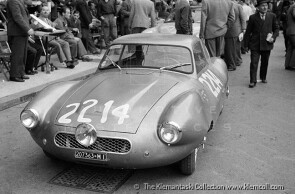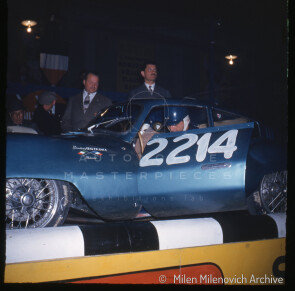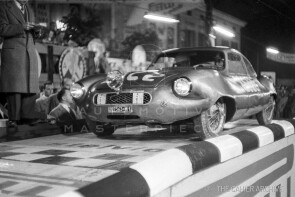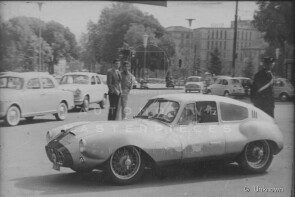
1952 Panhard Bianchi Gilco 750 Sport
ON/OFF
Why am I an Automotive Masterpiece?
D. Remaining cars from extremely limited production runs
1 of 2 manufactured
G. Team cars
Suderia Ital-France (IT)
L. Limited edition cars
. 1 of 2 manufactured
The Panhard Dyna X was a subcompact car produced by the French manufacturer Panhard from 1948 to 1953. It holds the distinction of being the first mass-produced car with an all-aluminum body. In 1943, engineer Jean-Albert Grégoire presented a car that incorporated many of the technical principles of the Amilcar Compound (notably its chassis and suspension). The project was initiated by Aluminium Français to promote the use of aluminum in automotive construction, but initially failed to attract the interest of manufacturers. However, under the framework of the “Plan Pons,” Panhard reached an agreement with Grégoire to continue development of the AFG prototype (Aluminium Français – Grégoire), providing the mechanical components. The result was the Dyna, featuring an aluminum body on a steel frame, an air-cooled 610 cc aluminum flat-twin engine, a four-speed gearbox, independent suspension on all four wheels (coil springs in front and torsion bars at the rear), and—most notably—front-wheel drive. The Dyna was first shown at the 1946 Paris Motor Show, and production began in October 1947, with bodywork subcontracted to Facel-Métallon (later known for producing the luxurious Facel Vega). From 1948, the car was sold as the Dyna X type 100 (X84), with only minimal changes from the 1946 prototype. The name referenced its top speed of 100 km/h. In 1950, the model gained a new grille with a central circular motif, and the type 110 (X85) replaced the 100. The 610 cc engine (classified as 3 CV) was upgraded from 22 to 28 hp (SAE). In April 1950, a new 745 cc engine (4 CV) producing 32–34 hp was introduced in the type 120 (X86). In February 1952, an optional Sprint version of the 4 CV engine offered 36–37 hp, thanks to a revised camshaft and a twin-barrel carburetor. In April, a roadster derivative named Dyna X Junior was launched. In June, the type 130 (X87) received a more powerful 5 CV / 851 cc engine, while the older types 110 and 120 were discontinued in December. For the 1953 model year, the type 130 could reach a top speed of 130 km/h when fitted with the Sprint 5 CV / 40 hp engine. The Dyna X was a surprisingly spacious vehicle for its class: at 3.82 meters long, it approached the dimensions of higher-segment cars, though its modest engine placed it in direct competition with models like the Renault 4CV, one of its main rivals. The Dyna X was available as a saloon, convertible, and station wagon, with a van version (Dyna K) also produced. Its design was decidedly unconventional, with a rounded body and protruding front headlights. Although the public was initially skeptical due to its unusual styling, the car eventually gained popularity for its agile handling and fuel economy. Performance was also commendable for the time. Built on a tubular chassis, the Dyna X’s aluminum alloy body kept its weight low, enhancing road performance. The model inspired many sporting interpretations, with coachbuilders creating aerodynamic sports cars, both open and closed. The Dyna X was discontinued in 1953 and replaced by the Panhard Dyna Z.
Usually, the name Crepaldi is closely linked to Ferrari’s world, as it was one of the first and most important Ferrari’s dealer. Crepaldi, anyway, was also the importer of the French Panhard in Italy. That’s why, with an eye to the promotion and a passion for the races, Gastone Crepaldi decided to make racing cars with Panhard mechanics. And that’s also why he created the Italfrance team around these cars. The team leader Aldo (Tino) Bianchi was, at the same time, the man that assembled the Sport Panhards. The heart was the Dyna X86 engine, an air-cooled boxer unit, two cylinder and 745cc. The first cars were all bodied by Allemano. With their front wheel drive, these little Sports changed the balances and some rules in early ‘50s. Moreover, the cars were continuously updated: Gilco was called to build a tubular “cage” chassis, using Fiat suspensions, and for 1953 a couple of them received, by the coachbuilder Colli, a “disco volante” shape similar to the shocking “disco volante” Alfa Romeo of the previous year, designed by Touring but built by Colli itself. Only two “disco” have been built and both have been raced. Only one of the two has kept this shape, while the other has evolved, once again, into a barchetta by Autocorse.
The Panhard Bianchi Gilco 750 Sport with chassis no. 008145 is one of the two examples produced and it is the one that has maintained its "disco volante" shape throughout its racing life; a shape that it still proudly wears today. Its history begins in May 1952, when it becomes property of the “Panhard et Levassor Paris” dealer in Novara, Boroli, and registered with an Italian plate. In January 1953, the car became property of the racing driver Franco Girardi who, in April, would take it to race the Mille Miglia. The car is out of luck: after passing Rome, leading the 750 category, and having covered most part of the race, unfortunately, the crankshaft broke. The following year, the car returned to the Mille Miglia, still under the aegis of the Ital-France team but with a different driver: Libero Bindi. Again, the car has no luck: half-way between Brescia and Rome, the car breaks down. The car will race again in 1959 at the 1st Rallye della Toscana and in the 60s. After a long period of oblivion, we find the car again in 2000 starting a second demanding career in historic races, Mille Miglia re-enactment in primis.





